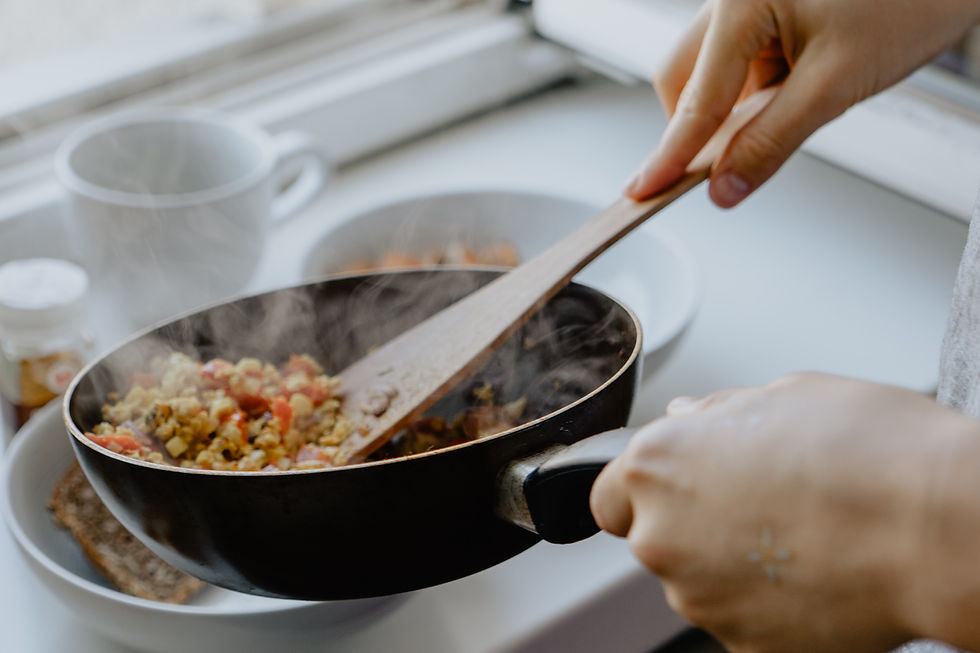Wait: My Cookware Can Be Toxic?
- Zuzka Valna

- Mar 30
- 4 min read

Hey there, home chefs and kitchen adventurers! 👋 It’s Zuzka, your friend from Merch with Merit, back with a topic that might make you side-eye your skillet: Could your cookware be sneaking nasties into your meals?
Before you panic and toss your pots out the window, let’s chat about what’s lurking in some cookware and how to choose safer, smarter options.
So, what’s the deal with toxic cookware?
Let’s start with the main culprits: PFAS, PTFE, and their sneaky cousins. You might know PTFE better by its brand name—Teflon. These non-stick coatings were all the rage for decades. But here’s the catch: when overheated, PTFE can break down and release toxic fumes (yikes). Even more concerning, PFOA, a chemical once used in making Teflon, has been linked to everything from hormone disruption to certain cancers. (Thankfully, it’s now largely phased out—but similar substances are still in use.)
PFAS chemicals, sometimes called “forever chemicals,” are particularly troubling. They stick around in our bodies and the environment, and we’re just starting to understand how harmful they can be. Not the kind of guest you want lingering in your kitchen.
Now, I’m not here to fearmonger. I’m here to empower you with better choices—because cooking should feel joyful, not questionable.
So what’s a health-conscious, food-loving home cook to do?
Great news—there are safe, non-toxic cookware options that won’t have you second-guessing every stir-fry. Here are four better choices, each with its own pros and cons.
1. Cast Iron: The Timeless Tank
Pros:
Naturally non-stick with proper seasoning
Incredibly durable—can last generations
Excellent heat retention
Cons:
Heavy! (Seriously, it can double as a heavy dumbbell)
Requires maintenance (hello, seasoning routine)
Can react with acidic foods
Verdict: Great for slow-cooked meals and rustic vibes. A bit high-maintenance, but worth it for the right cook.
2. Carbon Steel: Cast Iron's Cool Cousin
Pros:
Lightweight alternative to cast iron
Gets better with use (develops a seasoned patina)
Excellent for high-heat cooking
Cons:
Still needs seasoning and care
Can rust if not dried properly
May not be beginner-friendly
Verdict: A chef’s secret weapon. If you dig cast iron but want something more nimble, this is your jam. Amazing for searing and stir-frying.
3. Stainless Steel: The Sleek Workhorse
Pros:
Shiny, durable, and doesn’t react with acidic foods
No seasoning required
Long-lasting and dishwasher-safe
Great for browning and deglazing, aka flavor gold
Cons:
Not non-stick (hello, stuck-on scrambled eggs)
Can be tricky for beginners
Requires some technique - food sticks if you don’t master the heat/oil dance.
Verdict: A solid kitchen staple. Not fancy, not fussy—just reliable. Pair it with a little patience (and butter), and you’re golden.
4. Ceramic-Coated Cookware: The Happy Medium
Pros:
Free from PFAS, PTFE, lead, and cadmium
Naturally non-stick (without the sketchy chemicals)
Lightweight and easy to clean - wipe, rinse, repeat.
Modern designs in oh-so-many colors!
Cons:
Coating can wear over time (treat it kindly!)
Not ideal for super high-heat cooking
Needs gentle utensils (no metal, please)
Might wear out quickly
Verdict: For everyday cooking, this is my go-to. It’s safer, easier, and perfect for the home cook who just wants a great pan that works—without the health concerns. I personally use and love it, and I’ve tested several options to find what actually performs in real kitchens, not just pretty Instagram photos.
My Personal Choice: Yep, I’m Team Ceramic! 🎉 As someone who’s juggled everything from weeknight stir-fries to “oops, I forgot to stir” moments, ceramic-coated pans strike the perfect balance for most home cooks. They’re gentle on eggs, easy on arms, and don’t demand a PhD in seasoning or certificate from Cordon Bleu. Plus, they come in colors that make my kitchen look like a Pinterest board.
Pro-Tip: After cooking, let the pots and pans cool off, then wash with soap and water. I have used a little bit of baking soda on some stubborn stains (mostly on the outside coating).
Also: Be mindful of scratches: if you see them, it is time to replace your pans. I find that my skillets had to be replaced after about 18 months, since I use them so much. That is why I choose to spend less on skillets, and don't mind being spendier on the larger pots.
TL;DR? Let’s Wrap It Up
Toxic troublemakers: Avoid overheating non-stick pans with PFAS/PTFE.
Non-toxic MVPs: Cast iron, carbon steel, stainless steel, ceramic-coated.
My ride-or-die: Ceramic for ease, safety, and rainbow-colored skillets.
You don’t need a degree in chemistry to choose better cookware—just ditch the sketchy coatings and pick something that works as hard as you do.
And if you’re wondering which ceramic cookware is actually worth it—I’ve got you. I only recommend what I’ve personally used or did a deep dive on - and you will always know where I stand (look for an orange banner). You can find my top ceramic cookware picks right here → .
Got questions? Favorite cookware? Horror stories about that one pan you’ll never touch again? Drop by my Instagram and let’s geek out together!
Stay safe, stay savvy, and keep those spatulas flipping,
Zuzka, Merch with Merit




Comments